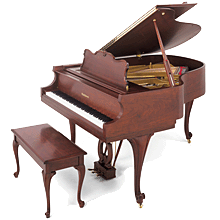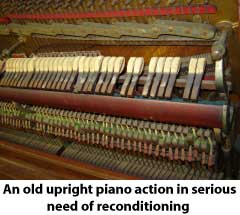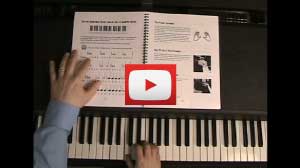Piano Maintenance

What does piano maintenance entail?
Tuning
Tuning is the most obvious part of regular piano maintenance. How often you should have your piano tuned depends on many factors. For the casual light user, twice yearly suffices. Once in the spring, when the heating system goes off, and the humidity starts to rise; and again in the fall when the humidity drops and the heating system comes on again.
More serious players, playing hours daily, may consider monthly tunings. For concerts, pianos are tuned early in the day of the performance, and then "touched up" right before the concert. Recording studios tune their pianos whenever the piano is used in a recording.
New pianos need to be tuned more often, because the piano strings are still stretching. It may easily take many tunings, over the course of months or years before a piano has completely settled.
Pianos are designed to be tuned to "Concert Pitch," which is A440. A piano that goes through a number of seasons without being tuned will drop in pitch, and will need to raised back to standard concert pitch. This may take two or three tunings, depending on how long since the last tuning, and how much the strings have already settled.
Consult a professional piano tuner to have your piano properly tuned.
Keep It Clean
This is easy piano maintenance! Keep the keys clean. Clean keys are more enjoyable to play. A little mild soap on a damp cloth will wipe grime, dust and other dirt away. Immediately dry off the keys with a dry towel.
Keep the case clean with a damp cloth, with no soap. Again, dry immediately.
Don't try to vacuum or dust the inside of the piano! You made dislodge or damage some of the many hundreds of working parts. And don't oil or lubricate any of the moving parts inside the piano. If it needs to be done, your piano technician will know what to do.
Piano Environment
Being a precision instrument made of wood, the piano is subject to the environment in which it is placed. Humidity plays a major role in the health of a piano. Keeping the humidity level even will prolong the piano's life. Most pianos are best kept at around 40-45% humidity level. Climates that change drastically from cold, dry winters to hot humid summers can wreak havoc on the wooden parts of a piano. There are humidity control devices (Damp Chaser) that can be added to a piano to tackle this problem.
It is best to place the piano away from any heat source, and preferably not against an outside wall. Don't place it in direct sunlight or near open windows. Try to minimize the effect of the weather and environment as much as possible.
Regulation
Part of piano maintenance is piano regulation. A properly regulated piano's action feels smooth and even from note to note. The relative volume is consistent, and the tone is also consistent. The action makes very little or no sound as you play, even in pianissimo passages.
An out of regulation piano with have keys that aren't level, an uneven feel, keys that feel like they "sink" too far, notes that "stutter" or repeat uncontrollably, and the action is noisy when played.
Some lesser expensive pianos are sold with minimal regulation, and may never get a proper regulation. A used piano almost certainly could use regulation. A heavily played instrument should be regulated on a regular basis.
Regulation is the adjustment of the moving parts in a piano. The action in an upright has more than 25 moving parts per note, and a grand will have more than 35 parts per note. Multiply this by 88, and this becomes a serious endeavor. A professional piano regulation can make a so-so piano much more enjoyable to play, and make you, the player, sound so much better!
Repairs
Occasionally, piano maintenance may mean repairs. Almost all repairs should be carried out by a professional piano technician. With all of the moving parts and specialized knowledge, it is best to have a pro do it right first.
The one exception is a "sticky note." Quite often (especially if there's kids around), the sticky note is caused by a pencil or some other object falling into the action. If you can see the culprit when looking inside, then carefully try to extract it.
Common repairs include broken strings, fixing worn or broken action parts, and replacing broken hammers and shanks.
Rebuilding/Reconditioning

The biggest job of piano maintenance is the rebuilding or reconditioning of a piano, and should be done by a professional.
Rebuilding is a complete overhaul, which may include completely disassembling the piano, installing a new soundboard, pin block, rebuilding the action, restringing, plus new pins, hammers and a cabinet refinishing.
Certain older pianos from the best manufacturers are prime candidates for rebuilding, and one could end up with a top quality like-new piano for a fraction of the price of a similar new piano.
Reconditioning is similar, but not quite as complete. Reconditioning usually involves fixing the action parts, regulation, new strings, pins and hammers, and maybe refinishing, depending on the needs of the instrument (and budget).
Start Playing Piano Today with the Piano Guide Quick Start Course!
Easy to follow step-by-step lessons designed for adult beginners. The next best thing to private lessons!
What You'll Learn:
- Notes on the piano/keyboard
- Proper fingering
- C major scale
- Chords
- How to read music
- And much more!

Video lessons - watch as I play everything for you.

